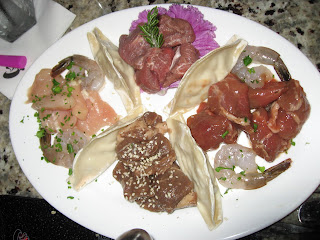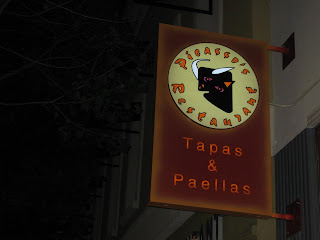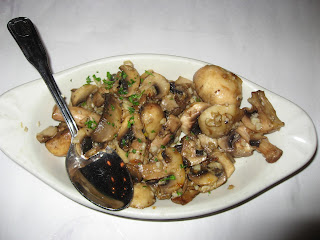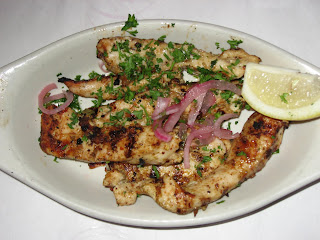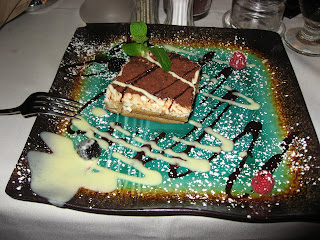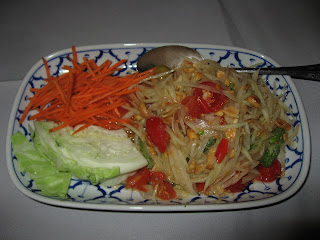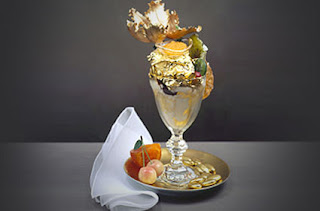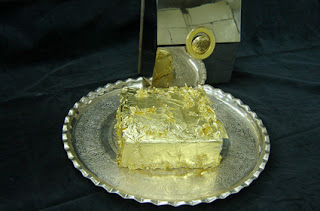That I have a sweet tooth doesn’t surprise anyone in India. Bengal is known for its wide variety of sweets and Bengali meals are incomplete without desserts. I never ever pass up an opportunity to try the desserts during dinner, especially when I am visiting a new place.
 Desserts have history. There is evidence of English sweet puddings during the 17th century made of flour, nuts and sugar. Food historians generally agree that custard, the sweet almost pudding-like substance we know today, dates to the Middle Ages. At that time custard was eaten alone or used as fillings for pies, tarts, pastry, etc. Flan -- an open tart filled with fruit, a cream, or a mixture -- was probably the most famous and widely adapted custard dessert in the world. It is important to note that custard was not unique to Europe. Similar recipes flourished in Asia. Note: Gulab Jamun picture by EliBlue and Gajar Halwa picture by Esherman.
Desserts have history. There is evidence of English sweet puddings during the 17th century made of flour, nuts and sugar. Food historians generally agree that custard, the sweet almost pudding-like substance we know today, dates to the Middle Ages. At that time custard was eaten alone or used as fillings for pies, tarts, pastry, etc. Flan -- an open tart filled with fruit, a cream, or a mixture -- was probably the most famous and widely adapted custard dessert in the world. It is important to note that custard was not unique to Europe. Similar recipes flourished in Asia. Note: Gulab Jamun picture by EliBlue and Gajar Halwa picture by Esherman.
 Among Indian desserts, there is evidence of Halwa in the 7th century. Halwa is derived from the Arabic word hulw which means sweet. In 7th century Arabia, the word meant a paste of dates kneaded with milk. By the 9th century, it had acquired a meaning of wheat flour or semolina, cooked by frying or toasting and worked into a stiff paste with a sweetening agent such as sugar syrup, date syrup, grape syrup, or honey by stirring the mass together over a gentle heat. Usually a flavoring was added such as nuts, rosewater, or pureed cooked carrots (still a popular flavoring). The finished sweetmeat would be cut into bars or molded into fanciful shapes. Halva spread both eastwards and westwards, with the result that is is made with a wide variety of ingredients, methods, and flavorings. Note: From Oxford Companion to Food, Alan Davidson [Oxford University Press 1999 (p. 367). Also: Rasmalai picture by Debra.
Among Indian desserts, there is evidence of Halwa in the 7th century. Halwa is derived from the Arabic word hulw which means sweet. In 7th century Arabia, the word meant a paste of dates kneaded with milk. By the 9th century, it had acquired a meaning of wheat flour or semolina, cooked by frying or toasting and worked into a stiff paste with a sweetening agent such as sugar syrup, date syrup, grape syrup, or honey by stirring the mass together over a gentle heat. Usually a flavoring was added such as nuts, rosewater, or pureed cooked carrots (still a popular flavoring). The finished sweetmeat would be cut into bars or molded into fanciful shapes. Halva spread both eastwards and westwards, with the result that is is made with a wide variety of ingredients, methods, and flavorings. Note: From Oxford Companion to Food, Alan Davidson [Oxford University Press 1999 (p. 367). Also: Rasmalai picture by Debra.
 Sweet shops in India have a far greater variety of sweet offerings on display than bakeries in the West. Many small towns and cities are known primarily for their sweets (Mithai in Hindi). Agra, home to the Taj Mahal, is also known for its Pethas, a unique sweet made from winter melon. Burdwan, in West Bengal, is known for its Mihidana which is rarely found outside this region and the famous Roshogollas of West Bengal are best tasted in the Oriya town of Pahala. The list goes on.
Sweet shops in India have a far greater variety of sweet offerings on display than bakeries in the West. Many small towns and cities are known primarily for their sweets (Mithai in Hindi). Agra, home to the Taj Mahal, is also known for its Pethas, a unique sweet made from winter melon. Burdwan, in West Bengal, is known for its Mihidana which is rarely found outside this region and the famous Roshogollas of West Bengal are best tasted in the Oriya town of Pahala. The list goes on.
 Unlike western desserts which are usually chocolate, whipped cream, or fruit-based, most Indian sweets are made of thickened milk, fresh curd cheese, or are flour-based. It’s difficult to provide a list of Indian desserts that is even close to being comprehensive. Even describing my personal favorites is difficult in a single post.
Unlike western desserts which are usually chocolate, whipped cream, or fruit-based, most Indian sweets are made of thickened milk, fresh curd cheese, or are flour-based. It’s difficult to provide a list of Indian desserts that is even close to being comprehensive. Even describing my personal favorites is difficult in a single post.
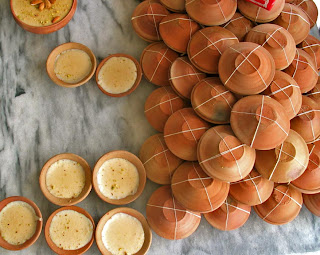 Kheer is an all time favorite. This creamy pudding is made in a wide variety of ways, with rice, with semolina, or just thickened milk sprinkled with chopped dry fruits. My mother always made this dish at home on my birthdays during childhood and that tradition still continues. Note: Kheer picture by Warina and Phirni picture by lecercle.
Kheer is an all time favorite. This creamy pudding is made in a wide variety of ways, with rice, with semolina, or just thickened milk sprinkled with chopped dry fruits. My mother always made this dish at home on my birthdays during childhood and that tradition still continues. Note: Kheer picture by Warina and Phirni picture by lecercle.
Phirni is a variation of the kheer, brought into India by the Mughals, and is a popular dessert after a meal of biryanis and kababs. Made of powdered rice and thickened milk, Phirni is usually chilled in small earthen pots and directly served in them.
 Next are the Gulab Jamuns, those delicious soft balls of fried milk solids immersed in sugar syrup and flavored with cardamom, saffron, or rose. In the olden days, Gulab Jamun was made with ‘bhatti khoya’, milk solids that were aged to six months producing a hard, aromatic khoya that was then grated, bound with maida (flour) into balls before being deep-fried and immersed in sugar syrup.
Next are the Gulab Jamuns, those delicious soft balls of fried milk solids immersed in sugar syrup and flavored with cardamom, saffron, or rose. In the olden days, Gulab Jamun was made with ‘bhatti khoya’, milk solids that were aged to six months producing a hard, aromatic khoya that was then grated, bound with maida (flour) into balls before being deep-fried and immersed in sugar syrup.
 Bengali sweets are mostly made of chhena, ripened fresh curd cheese which means they have to be eaten within a day or two of preparation. A wide variety of delights include the Roshogolla, Shondesh, Chomchom, and the Pantua. Note: Pictures of Bengali sweets above by Danburg Murmur and Debra.
Bengali sweets are mostly made of chhena, ripened fresh curd cheese which means they have to be eaten within a day or two of preparation. A wide variety of delights include the Roshogolla, Shondesh, Chomchom, and the Pantua. Note: Pictures of Bengali sweets above by Danburg Murmur and Debra.
Rasmalai is another favorite, especially with those who are new to Indian sweets. Mildly sweet, these dumplings are made from cottage or ricotta cheese in thickened milk, delicately flavored with cardamoms and topped with crushed pistachios.
 Then there are the large variety of Laddoos and Burfis. Made of a variety of different ingredients, these come in various flavors, colors and sizes. I especially love Motichur laddoos, commonly used as religious offerings in Indian festivals, and Kaju Barfis made from cashewnut paste and available in a wide variety of variations. Note: Pictures of laddoos and burfis by Danburg Murmur.
Then there are the large variety of Laddoos and Burfis. Made of a variety of different ingredients, these come in various flavors, colors and sizes. I especially love Motichur laddoos, commonly used as religious offerings in Indian festivals, and Kaju Barfis made from cashewnut paste and available in a wide variety of variations. Note: Pictures of laddoos and burfis by Danburg Murmur.
 And finally, a dessert from Western India where I now live: the Shrikhand. The Shrikhand is a creamy dessert made out of strained yogurt, from which all water is drained off, leaving the thick yogurt cream by itself. Adding exotic dry fruits like mangos only enhances the Shrikhand’s delightful taste to newer limits.
And finally, a dessert from Western India where I now live: the Shrikhand. The Shrikhand is a creamy dessert made out of strained yogurt, from which all water is drained off, leaving the thick yogurt cream by itself. Adding exotic dry fruits like mangos only enhances the Shrikhand’s delightful taste to newer limits.
And so dear readers, like Erma Bombeck once pointed out, “Seize the moment. Remember all those women on the Titanic who waved off the dessert cart.” :-)
Read More...




